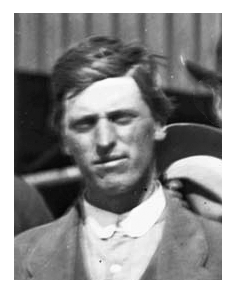Charles H. Sharman facts for kids
Quick facts for kids
Charles H. Sharman
|
|
|---|---|

Sharman at UPRR Golden Spike ceremony
|
|
| Born | 1841 Ireland
|
| Died | January 7, 1938 (aged 96–97) |
| Resting place | Fayetteville, Arkansas, US |
| Nationality | American |
| Education | civil engineering |
| Spouse(s) | Anna Sharman (-1923) |
| Children | Florence S. Altizer (1876-1946) |
| Engineering career | |
| Discipline | Civil |
| Institutions | Iowa central college |
| Employer(s) | Union Pacific railroad |
| Projects | First transcontinental railroad |
| Significant design | Grand Island and Dale creek bridges |
Charles H. Sharman (1841-1938) was a civil engineer. He played a big part in building the Union Pacific Railroad. This railroad connected to the Central Pacific Railroad at Promontory Summit, Utah in 1869. Sharman was there for the famous Golden spike ceremony on May 10, 1869. This event joined the two railroads, creating the first transcontinental railroad across America. He also appeared in a famous photo taken that day by Andrew J. Russell.
After the Union Pacific Railroad was finished, Sharman worked for other railroads. He retired in 1920 and moved to Fayetteville, Arkansas. Sharman wrote about his experiences building the railroad. His writings later inspired a story called "Trouble Shooter" by Western author Ernest Haycox. This story was published in Collier's magazine in 1936. "Trouble Shooter" then became the basis for the movie Union Pacific, released in 1939.
Contents
Early Life and Building the Railroad
Sharman was born in Ireland in 1841. His family moved to the United States in the early 1850s, first living in Erie, Pennsylvania. In 1853, his father passed away, and the family moved to Des Moines, Iowa.
Becoming an Engineer
Sharman studied civil engineering at Iowa Central College. But he left school in 1862 to join the Union Army during the American Civil War. He served in the Thirty-third Iowa infantry. In August 1865, Sharman was discharged from the army. By the spring of 1866, he arrived in Omaha, Nebraska. He was looking for work with the Union Pacific Railroad's civil engineering team.
Working on the Union Pacific
In Omaha, Sharman met Herbert Melville Hoxie, another engineer from Iowa. Hoxie was building the first 100 miles of track west from Omaha. Sharman had met Hoxie before, when Sharman was a young messenger boy in Iowa.
Sharman then applied to Samuel B. Reed, who was the superintendent of construction for the UPRR. Reed hired Sharman to work for Francis M. Case, a division engineer. Sharman's jobs included working near Grand Island, helping with the North Platte River railroad bridge, and working at the Dale Creek crossing in 1867 and 1868.
Building the railroad was dangerous. At one point, Sharman was assigned to a survey team led by Percy Browne. Sharman was later reassigned to a different job. Sadly, Browne's team was attacked, and both Browne and Sharman's replacement were killed.
Sharman also worked with other important civil engineers on the project. He met Hezekiah Bissell, and together they helped mark the center line for the railroad contractor, General "Jack" Casement. Sharman also worked with General Marshall Farnum Hurd. Hurd was in charge of finding the best place to cross the wide and dangerous North Platte River in 1867. During this time, Sharman also met Arthur Northcut Ferguson, who later became a chief justice in Nebraska.
Legacy and Impact
After the Union Pacific Railroad was completed, Charles Sharman continued to work for various railroads in the Midwest. In 1920, he retired to Fayetteville, Arkansas.
Sharman kept a detailed journal about his experiences building the transcontinental railroad. This journal became very important. It provided the original ideas for Western fiction author Ernest Haycox to write his story "Trouble Shooter." This story was published in Collier's magazine in 1936. Because of Sharman's writings, this story later became the basis for the major motion picture Union Pacific, which came out in 1939. So, a civil engineer's notes helped create a famous movie!


